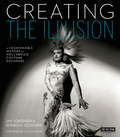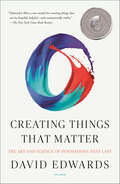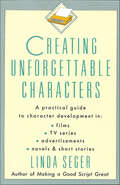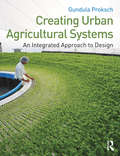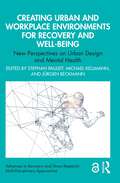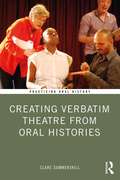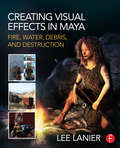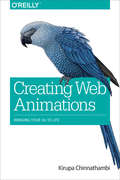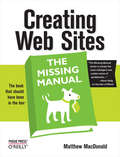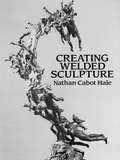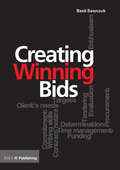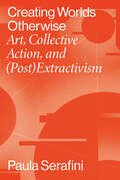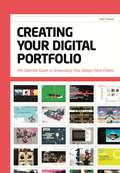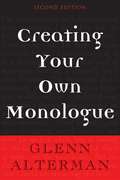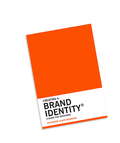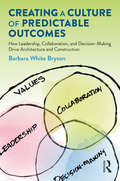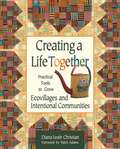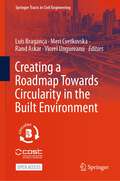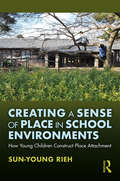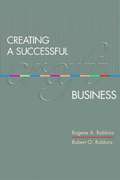- Table View
- List View
Creating Textures in Watercolor: A Guide to Painting 83 Textures from Grass to Glass to Tree Bark to Fur
by Cathy JohnsonSilken strands of hair. Water tumbling over rocks. Blinding reflections in glass or metal.Cathy Johnson shows you how to create realistic textures like these and make your watercolor paintings come alive.You'll find practical, easy-to-follow guidelines inside for creating 83 wonderful textures for fruits, vegetables, hair, glass, metal, fabric, flowers, fur, skin and much, much more.Johnson's beautiful watercolor sketches - complete with helpful captions - demonstrate each of these techniques and their many variations. You'll learn how to accurately recreate any texture you see and create lovely watercolor paintings that almost seem to breathe.Cathy Johnson's expertise will show you how to expand your own artistic vision and discover a world of textures - a world you can capture with your brush.
Creating The Illusion: A Fashionable History Of Hollywood Costume Designers (Turner Classic Movies)
by Jay Jorgensen Donald L. ScogginsMarilyn Monroe made history by standing over a subway grating in a white pleated halter dress designed by William Travilla. Hubert de Givenchy immortalized the Little Black Dress with a single opening scene in Breakfast at Tiffany’s. A red nylon jacket signaled to audiences that James Dean was a Rebel Without a Cause. For more than a century, costume designers have left indelible impressions on moviegoers’ minds. Yet until now, so little has been known about the designers themselves and their work to complement and enrich stories through fashion. Creating the Illusion presents the history of fashion on film, showcasing not only classic moments from film favorites, but a host of untold stories about the creative talent working behind the scenes to dress the stars from the silent era to the present day. Among the book’s sixty-five designer profiles are Clare West, Howard Greer, Adrian, Walter Plunkett, Travis Banton, Irene, Edith Head, Cecil Beaton, Bob Mackie, and Colleen Atwood. The designers’ stories are set against the backdrop of Hollywood: how they collaborated with great movie stars and filmmakers; how they maneuvered within the studio system; and how they came to design clothing that remains iconic decades after its first appearance. The array of films discussed and showcased through photos spans more than one hundred years, from draping Rudolph Valentino in exotic "sheik” dress to the legendary costuming of Gone with the Wind, Alfred Hitchcock thrillers, Bonnie and Clyde, Reservoir Dogs, and beyond. This gloriously illustrated volume includes candid photos of the designers at work, portraits and wardrobe tests of stars in costume, and designer sketches. Drawing from archival material and dozens of new interviews with award-winning designers, authors Jay Jorgensen and Donald L. Scoggins offer a highly informative, lavish, and entertaining history of Hollywood costume design.
Creating Things That Matter: The Art and Science of Innovations That Last
by David EdwardsMost things we create will not matter. This book is about creating things that do, from a master innovator who brings science and art together in his cutting edge labs.Art and science are famous opposites. Contemporary innovation mostly keeps them far apart. But in this book, David Edwards—world-renowned inventor; Harvard professor of the practice of idea translation; creator of breathable insulin, edible food packaging, and digital scents—reveals that the secret to creating very new things of lasting benefit, including innovations we will need to sustain human life on the planet, lies in perceiving art and science as one.Here Edwards shares how he discovered a way of creating that transcends disciplines and incorporates the principles of aesthetics. He introduces us to cutting-edge artists, musicians, architects, physicists, mathematicians, engineers, chefs, choreographers, and novelists (among others) and uncovers a three-step cycle they all share in creating things that durably matter. This creator cycle looks unlike what we associate with game-changing innovation today, and aligns the most expressive art and the most revolutionary science in a radical reimagining of how we live. David Edwards and the innovators he profiles belong to an emerging grassroots renaissance flourishing in special environments that we all can make in our schools, companies and homes.Creating Things That Matter is a book for anyone wondering what tomorrow might be, and at last half believing that what they do can make a difference.
Creating Unforgettable Characters: A Practical Guide to Character Development in Films, TV Series, Advertisements, Novels & Short Stories
by Linda SegerFrom a longtime script consultant, “a vital aid to all writers, novelists, and screenwriters . . . invaluable” (Gale Anne Hurd, producer, The Walking Dead and Aliens).In this book, Linda Seger, author of Making a Good Script Great, shows how to create strong, multidimensional characters in fiction, covering everything from research to character block. She introduces concepts designed to stimulate the creative process, combining them with practical techniques and exercises. She also offers specific advice on creating nonfiction and fantasy characters, and case studies of such classics as Ordinary People and the sitcom Cheers.Addressing topics from backstory development to character psychology to avoiding stereotypes, Creating Unforgettable Characters is an excellent resource for writers in any genre or creative field. Interviews with successful professional writers complete this essential volume.
Creating Urban Agricultural Systems: An Integrated Approach to Design
by Gundula ProkschCreating Urban Agriculture Systems provides you with background, expertise, and inspiration for designing with urban agriculture. It shows you how to grow food in buildings and cities, operate growing systems, and integrate them with natural cycles and existing infrastructures. It teaches you the essential environmental inputs and operational strategies of urban farms, and inspires community and design tools for innovative operations and sustainable urban environments that produce fresh, local food. Over 70 projects and 16 in-depth case studies of productive, integrated systems, located in North America, Europe, and Asia ,are organized by their emphasis on nutrient, water, and energy management, farm operation, community integration and design approaches so that you can see innovative strategies in action. Interviews with leading architecture firms, including WORKac, Kiss + Cathcart, Weber Thompson, CJ Lim/Studio 8, and SOA Architectes, highlight the challenges and rewards you face when creating urban agriculture systems. Catalogs of growing and building systems, a glossary, bibliography, and abstracts will help you find information fast.
Creating Urban and Workplace Environments for Recovery and Well-being: New Perspectives on Urban Design and Mental Health (Advances in Recovery and Stress Research)
by Stephan Pauleit Michael Kellmann Jürgen BeckmannThis essential book offers suggestions for how cities and spaces can be planned and designed to reduce the impact of stress, provide opportunities for recovery, and promote the resilience of individuals in urban communities.Connecting research from different scientific disciplines, the book provides a broader perspective of creating healthy lifestyle in society. It focuses on mental health and well-being by exploring how urban and workplace environments can be created to enhance and promote recovery. Divided into three parts, the book begins by investigating the multi-dimensional challenges of planning and design for stress reduction and recovery in urban areas. Part 2 concentrates on the design of residential and working environments, including commuting between the two, while Part 3 considers how neighbourhoods and entire cities contribute to or obstruct stress reduction, recovery, and well-being. The book concludes by demonstrating how the insights from the book can be implemented in practice to create restorative and inclusive environments. Bringing together leading experts, the book offers an interdisciplinary perspective for increasing well-being in urban developments.The book will be of interest to researchers and practitioners in related fields, including environmental psychologists, urban planners, architects and landscape architects, healthcare staff, and policymakers.
Creating Verbatim Theatre from Oral Histories (Practicing Oral History)
by Clare SummerskillOffering a roadmap for practicing verbatim theatre (plays created from oral histories), this book outlines theatre processes through the lens of oral history and draws upon oral history scholarship to bring best practices from that discipline to theatre practitioners. This book opens with an overview of oral history and verbatim theatre, considering the ways in which existing oral history debates can inform verbatim theatre processes and highlights necessary ethical considerations within each field, which are especially prevalent when working with narrators from marginalised communities. It provides a step-by-step guide to creating plays from interviews and contains practical guidance for determining the scope of a theatre project: identifying narrators and conducting interviews, developing a script from excerpts of interview transcripts and outlining a variety of ways to create verbatim theatre productions. By bringing together this explicit discussion of oral history in relationship to theatre based on personal testimonies, the reader gains insight into each field and the close relationship between the two. Supported by international case studies that cover a wide range of working methods and productions, including The Laramie Project and Parramatta Girls, this is the perfect guide for oral historians producing dramatic representations of the material they have sourced through interviews, and for writers creating professional theatre productions, community projects or student plays.
Creating Vibrant Public Spaces: Streetscape Design in Commercial and Historic Districts
by Ned CrankshawPublic space and street design in commercial districts can dictate the success or failure of walkable community centers. Instead of focusing our efforts on designing new "compact town centers," many of which are located in the suburbs, we should instead be revitalizing existing authentic town centers. This informative, practical book describes methods for restoring the health and vibrancy of the streets and public spaces of our existing commercial districts in ways that will make them positive alternatives to suburban sprawl while respecting their historic character. Clearly written and with numerous photos to enhance the text, Creating Vibrant Public Spaces uses examples from communities across the United States to illustrate the potential for restoring the balance provided by older urban centers between automobile access and "walkability." In advice that can be applied to a variety of settings and scales, Crankshaw describes the tenets of contemporary design theory, how to understand the physical evolution of towns, how to analyze existing conditions, and how to evaluate the feasibility of design recommendations. Good design in commercial centers, Crankshaw contends, facilitates movement and access, creates dynamic social spaces, and contributes to the sense of a "center"--a place where social, commercial, and institutional interaction is more vibrant than in surrounding districts. For all the talk of creating new "green" urban spaces, the ingredients of environmentally aware design, he points out, can often be found in the deteriorating cores and neighborhoods of towns and cities across the United States. With creativity, planning, and commitment, these centers can thrive again, adding to the quality of local life and contributing to the local economy, too.
Creating Visual Effects in Maya: Fire, Water, Debris, and Destruction
by Lee LanierProduce mind-blowing visual effects with Autodesk Maya. Gain the practical skills and knowledge you need to recreate phenomena critical to visual effects work, including fire, water, smoke, explosions, and destruction, as well as their integration with real-world film and video. In Creating Visual Effects in Maya, Maya master Lee Lanier has combined the latest studio techniques with multi-chapter, hands-on projects and professionally-vetted workflows to bolster your CG toolkit. Engaging, full-color tutorials cover: Creating foliage, fire, and smoke with Paint Effects Growing Maya Fur and nHair on clothing, characters, and sets Replicating water, smoke, sparks, swarms, bubbles, and debris with nParticles and nCloth Controlling scenes and simulations with expressions and MEL, Python, and PyMEL scripting Adding dust, fog, smoke, rippling water, and fireballs with Fluid Effects containers Creating damage with Effects presets, deformers, and animated textures Matchmoving and motion tracking with Maya and MatchMover Creating complex destruction by combining rigid bodies, nParticles, nCloth, and Fluid Effects Setting up, rendering, and compositing mental ray render passes with Autodesk Composite, Adobe After Effects, and The Foundry Nuke The companion website (www.focalpress.com/cw/lanier) features a treasure trove of Maya, MatchMover, After Effects, and Nuke project files, image sequences, texture bitmaps, and MEL, Python, and PyMEL scripts, allowing you to immediately apply the techniques taught in the book.
Creating Visual Narratives Through Photography: A Fresh Approach to Making a Living as a Photographer
by Mike DavisThis book provides photographers with the foundation to craft more compelling photos from concept all the way through to creation and distribution, on the path to making a living. Based on real-life practice and experience, former National Geographic and White House visual editor, Mike Davis, takes readers on a journey starting with addressing the motivation behind an image and how this determines the rest of the creative process. He goes on to articulate best technical practices to create the narrative through photo composition and what to do with your work after the photos are completed. Each section offers exercises for applied learning and a series of appendices cover assignments structures, a compilation of critical words and concepts, a comprehensive resource guide of organizations, competitions, grants, collectives and agencies, book publishers and printers, and more. This is an ideal resource for students and practitioners alike to gain a more informed understanding of photographic expression and learn how to effectively execute these visions.
Creating Web Animations: Bringing Your UIs to Life
by Kirupa ChinnathambiThanks to faster browsers, better web standards support, and more powerful devices, the web now defines the next generation of user interfaces that are fun, practical, fluid, and memorable. The key? Animation. But learning how to create animations is hard, and existing learning material doesn’t explain the context of the UI problem that animations are trying to solve. That’s where this book comes in.You'll gain a solid technical understanding of how to create awesome animations using CSS and learn how to implement common UI patterns, using practical examples that rely on animations to solve a core problem. Frontend web developers and designers will not only learn important technical details, but also how to apply them to solve real-world problems.Create animations found in common user interface implementations, such as bounce after scrolling, expanding search boxes, and content slidersLearn the technical details of working with CSS animations and transitionsUse CSS transforms to very animate an element’s position, scale, and orientationUnderstand the importance of easing
Creating Web Sites: The Missing Manual (Missing Manual)
by Matthew MacDonaldThink you have to be a technical wizard to build a great web site? Think again. For anyone who wants to create an engaging web site--for either personal or business purposes--Creating Web Sites: The Missing Manual demystifies the process and provides tools, techniques, and expert guidance for developing a professional and reliable web presence.Like every Missing Manual, you can count on Creating Web Sites: The Missing Manual to be entertaining and insightful and complete with all the vital information, clear-headed advice, and detailed instructions you need to master the task at hand. Author Matthew MacDonald teaches you the fundamentals of creating, maintaining, and updating an effective, attractive, and visitor-friendly web site--from scratch or from an existing site that's a little too simple or flat for your liking.Creating Web Sites: The Missing Manual doesn't only cover how to create a well-designed, appealing, smart web site that is thoroughly up to date and brimming with the latest features. It also covers why it's worth the effort by explaining the rationale for creating a site in the first place and discussing what makes a given web site particularly aesthetic, dynamic, and powerful. It further helps you determine your needs and goals and make well informed design and content decisions.Creating Web Sites: The Missing Manual includes a basic primer on HTML, working with JavaScript, and incorporating services like Paypal's shopping cart, Amazon's associate program, and Google AdSense and AdWords. It delivers advanced tricks for formatting, graphics, audio and video, as well as Flash animation and dynamic content. And you'll learn how to identify and connect with your site's audience through forms, forums, meta tags, and search engines.This isn't just another dry, uninspired book on how to create a web site. Creating Web Sites: The Missing Manual is a witty and intelligent guide for all of you who are ready to make your ideas and vision a web reality.
Creating Welded Sculpture (Dover Art Instruction)
by Nathan Cabot HaleIn this generously illustrated guide, newly revised and updated, a well-known American sculptor shares his forty years of experience working with welded sculpture techniques. Nathan Cabot Hale begins with the basic assumption that it is necessary for a sculptor-welder to have the same professional skills as a good job-welder. To help readers gain those skills, he demonstrates both traditional and comparatively new welding methods step by step, including the oxyacetylene technique in modeling small-scale figurative sculpture.Mr. Hale first discusses the basic tools and techniques of welded sculpture, then addresses the construction of abstract and organic shapes and modeling solid figures. This is followed by detailed coverage of finishing techniques, arc welding, and welding large-scale commissioned works. He even dispenses helpful practical advice on the economics of fine art -- exhibiting work, staying alive, searching out public and private support, and more. Over 80 helpful diagrams and more than 100 photographs accompany the text, demonstrating techniques and procedures and depicting works in progress as well as finished works. In a new chapter written specially for this edition, Mr. Hale shares the heartening artistic philosophy he has developed over his long and distinguished career. Sculptors at many levels of accomplishment will find his book instructive and inspiring.
Creating Winning Bids
by Basil Sawczuk'Creating Winning Bids' sets out the key stages in the production of a winning bid. Based on tried and tested methods, and using a simple step-by-step process, it will improve your chances of success in what can otherwise seem a daunting and complex process. Distilling the author’s experience of over 25 years of bidding in the public and private sectors, it is packed with practical tips about what your client really wants to see. Beginning with a concise look at how to find new opportunities for work, it examines the various types of bid that can be made and includes invaluable explanations of the jargon used in the bidding process – from OJEU to PQQs. Illustrated throughout with useful diagrams and checklists, and covering a range of procurement routes, this guide will help anyone from the sole practitioner to the large firm with a dedicated bidding team to create practical and perfectly-tailored winning bids.
Creating Worlds Otherwise: Art, Collective Action, and (Post)Extractivism (Performing Latin American and Caribbean Identities)
by Paula SerafiniExtractivism has increasingly become the ground on which activists and scholars in Latin America frame the dynamics of ecological devastation, accumulation of wealth, and erosion of rights. These maladies are the direct consequences of longstanding extraction-oriented economies, and more recently from the expansion of the extractive frontier and the implementation of new technologies in the extraction of fossil fuels, mining, and agriculture. But the fields of sociology, political ecology, anthropology, and geography have largely ignored the role of art and cultural practices in studies of extractivism and post-extractivism. The field of art theory, on the other hand, has offered a number of texts that put forward insightful analyses of artwork addressing extraction, environmental devastation, and the climate crisis. However, an art theory perspective that does not engage firsthand and in depth with collective action remains limited and fails to provide an account of the role, processes, and politics of art in anti- and post-extractivist movements.Creating Worlds Otherwise examines the narratives that subaltern groups generate around extractivism, and how they develop, communicate, and mobilize these narratives through art and cultural practices. It reports on a two-year research project into creative resistance to extractivism in Argentina and builds on long-term engagement working on environmental justice projects and campaigns in Argentina and the UK. It is an innovative contribution to the fields of Latin American studies, political ecology, cultural studies, and art theory, and addresses pressing questions regarding what post-extractivist worlds might look like as well as how such visions are put into practice.
Creating Writers: A Creative Writing Manual for Schools
by James CarterThis unique and comprehensive text offers an original approach to teaching creative writing by exploring ideas, giving advice, and explaining workshop activities and has many contributors from some of today's most popular children's authors including: Jacqueline Wilson, Roger McGough, Philip Pullman, Malorie Blackman and David Almond.Creating Writers is a practical writing manual for teachers to use with upper primary and lower secondary level pupils that covers poetry, fiction and non-fiction.
Creating Your Digital Portfolio: The Essential Guide to Showcasing Your Design Work Online
by Ian ClazieThis book will help graphic designers, illustrators, and other creative professionals navigate the challenge of creating a digital portfolio. It contains practical advice to getting your work into a portable digital format ready to share on the web. It also discusses the thinking behind creating a portfolio, your objectives, and communication strategy.
Creating Your Own Monologue
by Glenn AltermanIn the second edition of this popular guide, actors learn to use their skills to write monologues, performance art pieces, and one-person plays. Updated to include exclusive interviews and tips on marketing, this guide helps actors create their own exciting performance opportunities and follow in the footsteps of Elaine Stritch, Billy Crystal, John Leguizamo, and other stunningly successful writer-performers of one-person shows. The author, an award-winning actor, breaks down the writing process into simple steps, coaching the reader through each stage of the creative journey.
Creating a Brand Identity: A Guide for Designers
by Catharine Slade-BrookingCreating a brand identity is a fascinating and complex challenge for the graphic designer. It requires practical design skills and creative drive as well as an understanding of marketing and consumer behaviour. This practical handbook is a comprehensive introduction to this multifaceted process.Exercises and examples highlight the key activities undertaken by designers to create a successful brand identity, including defining the audience, analyzing competitors, creating mood boards, naming brands, designing logos, presenting to clients, rebranding and launching the new identity.Case studies throughout the book are illustrated with brand identities from around the world, including a diverse range of industries – digital media, fashion, advertising, product design, packaging, retail and more.
Creating a Brand Identity: A Guide for Designers
by Sue JenkynCreating a brand identity is a fascinating and complex challenge for the graphic designer. It requires practical design skills and creative drive as well as an understanding of marketing and consumer behaviour. This practical handbook is a comprehensive introduction to this multifaceted process.Exercises and examples highlight the key activities undertaken by designers to create a successful brand identity, including defining the audience, analyzing competitors, creating mood boards, naming brands, designing logos, presenting to clients, rebranding and launching the new identity.Case studies throughout the book are illustrated with brand identities from around the world, including a diverse range of industries – digital media, fashion, advertising, product design, packaging, retail and more.
Creating a Culture of Predictable Outcomes: How Leadership, Collaboration, and Decision-Making Drive Architecture and Construction
by Barbara White BrysonCreating a Culture of Predictable Outcomes demonstrates the importance of creating cultures in the design and construction industries grounded in sophisticated-caring leadership, high-performing collaborative teams, and master-level decision-making discipline, informed by values, to finally address massive inefficiencies, waste, and unpredictability. Barbara White Bryson offers specific guidance to industry stakeholders to succeed in achieving project-related predictable outcomes by focusing on culture rather than process. This includes selecting the right team members by hiring and firing bravely, valuing psychological safety, leading with values, practicing respect and transparency, fostering empowerment to make decisions at the right level at the right time, and more. This book is a must-read for design and construction professionals who want to finally understand how to set goals and meet those goals for their clients as well as for their teams.
Creating a Life Together
by Patch Adams Diana Leafe ChristianCreating a Life Together is the only resource available that provides step-by-step practical information distilled from numerous firsthand sources on how to establish an intentional community. It deals in depth with structural, interpersonal and leadership issues, decision-making methods, vision statements, and the development of a legal structure, as well as profiling well-established model communities. This exhaustive guide includes excellent sample documents among its wealth of resources.Diana Leafe Christian is the editor of Communities magazine and has contributed to Body & Soul, Yoga Journal, and Shaman's Drum, among others. She is a popular public speaker and workshop leader on forming intentional communities, and has been interviewed about the subject on NPR. She is a member of an intentional community in North Carolina.
Creating a Roadmap Towards Circularity in the Built Environment (Springer Tracts in Civil Engineering)
by Viorel Ungureanu Luís Bragança Meri Cvetkovska Rand AskarThis open access book summarizes the research being pursued as part of the COST Action CA21103 titled "Implementation of Circular Economy in the Built Environment" (Circular B), which aims to define the methodology to develop a common circularity framework for inclusive application and assessment in new and existing buildings to support decision-making for all value chain stakeholders and appraise the implementation level of the European Circular Economy Action Plan (CEAP). The Action is increasingly gaining interest worldwide, bringing multidisciplinary young and experienced researchers together to share the latest studies and develop new knowledge. Consisting of 17 chapters corresponding to the conference themes, the book analyses and discusses topics such as Circular Economy (CE) best practices, design strategies for circular buildings, circular materials and products, adaptive reuse of existing buildings, recovery and reuse of salvaged materials and products, case studies of current applications and trends, barriers against CE implementation in buildings, efficient waste and circular resource management, circular lifecycle management and decision making, stakeholders relationships, CE supporting policies and barriers, circular business models, criteria, KPIs and assessment models for circular buildings, CE criteria in sustainability frameworks, digitalization and BIM for enhanced circularity of buildings and building materials, and standardization of CE definitions in buildings.
Creating a Sense of Place in School Environments: How Young Children Construct Place Attachment
by Sun-Young RiehCreating a Sense of Place in School Environments guides its readers to the characteristics that tend to generate a sense of place through children’s vivid descriptions of their school and provides a body of critical information that can be employed to design a better school environment that can imprint cherished childhood memories. The childhood school environment calls for special attention regarding the sense of place it creates. The sense of place in childhood both affects children's current quality of life and frames their lasting world view. It is well known that children's cognitive development is closely related to their place attachment to their surroundings, and that children’s adaptation to a given environment depends on how such place attachment can be created. Therefore, it is natural that people’s identity in the world is the accumulation of their experience of place while in childhood. Cross-checking between the imprint of adults' memories of places in school and children’s current "lived experience" of their favorite school place confirmed that certain spatial configurations, which the author herein refers to as "place generators" can generate positive attributes of physical settings that construct a sense of place and last as lifelong memories. It is an ideal read for academics, students, and professionals.
Creating a Successful Craft Business
by Rogene A. Robbins Robert RobbinsFrom writing a business plan and financing an idea to choosing the most cost-efficient production method and best-suited sales approach, Creating a Successful Crafts Business provides a sound blueprint for turning a beloved hobby into a lucrative career. Written by two experienced craftspeople who have been through the trials, tribulations, and triumphs of running a crafts business, readers will learn, step by step, how to negotiate with bankers, choose the ideal retail location, promote the business on-line, expand into lucrative new markets, and much more. Filled with the infectious spirit of people who have "been there," this down-to-earth book will bring fledging craft businesses to new levels of profits and success.

